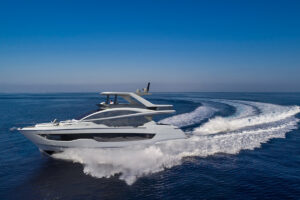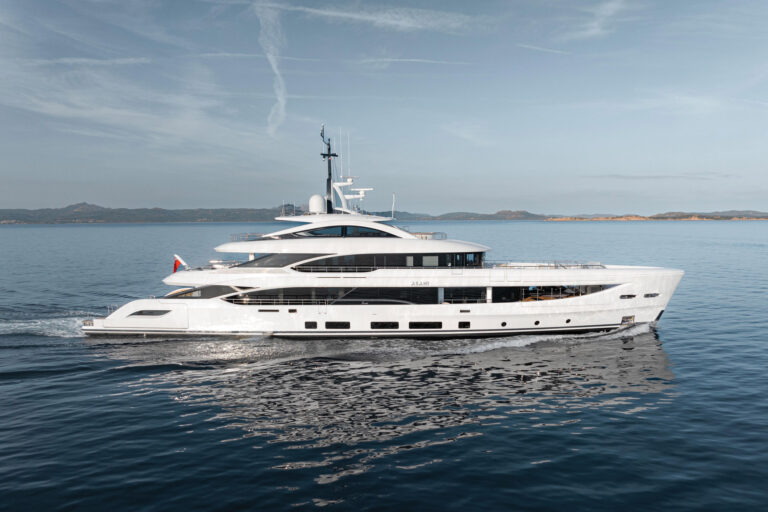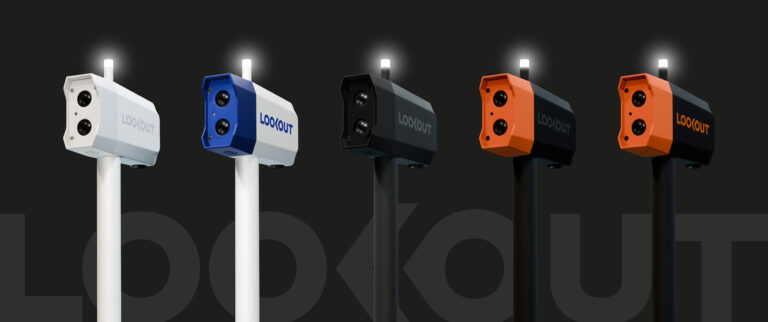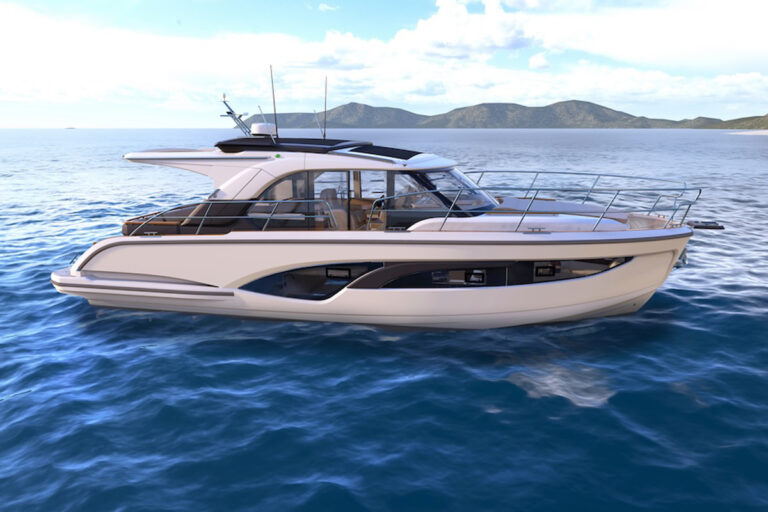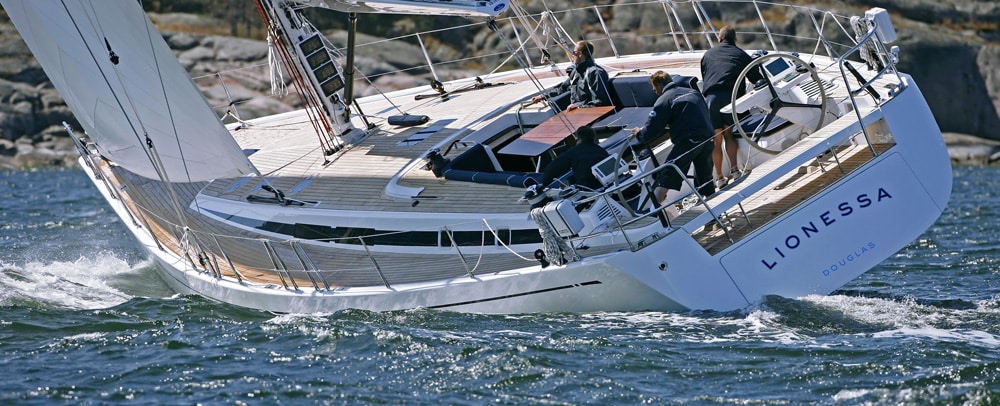
Swan 66 FD Main
Lionessa, hull No. 1 of the Swan 66 FD, won her class in the 2010 Atlantic Rally for Cruisers. Cynics may say “so what?” but this victory proves a point — Nautor’s asked German Frers to design a cruising yacht that the owner could race. Whatever the primary role this yacht plays in the owner’s life, no one will mistake its pedigree.
Although Nautor’s Swan has built quite a variety of yachts — puffy-looking cruising yachts and motorsailers among them — the style that made the company’s reputation is the flush-deck, dual-purpose yacht, in sloop and ketch models. The most significant of these has to be the Swan 65 ketch Sayula II, which won the first-ever Whitbread Round the World Race in 1973-1974. The performance of this Sparkman & Stephens design proved that cruiser/racers really function as advertised.
Since the 1970s, Swan has maintained its strong visual identity via the arrow motif in the cove stripe and the blue accent band along the sides of the trunk cabin. More distinctive still are the wedge shape of the trunk cabin, flush deck and dual cockpits — one for pleasure and one for work. Lionessa perpetuates these design cues, I’m happy to report, because they work very well.
So does the rest of the boat — well, almost all of it. From my first experience aboard a Swan to this most recent one, I’ve always thought that the companionway stairs are too steep and the treads too shallow. On the other hand, each tread curves upward at the ends, which provides a relatively level step when the boat’s heeling, and it also has an anti-slip surface. Descending these stairs aboard Lionessa rewards you with a traditional arrangement plan and high-quality teak joinery, hand-rubbed to a satiny finish. Swan continues to honor the Scandinavian penchant for cleanly designed cabinetry and furniture — lots of straight lines connected by graceful curves — which puts everyone at ease. I immediately felt a tug from the settee on the starboard side of the salon. “Join me for a drink and the latest issue of the ClubSwan Magazine.”
View a complete photo gallery.
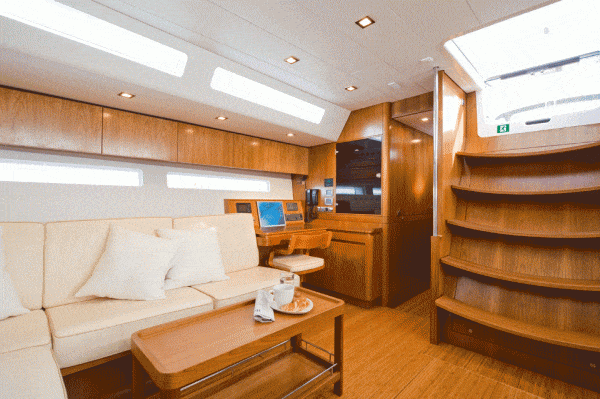
An abundance of unstained varnished teak woodwork casts a honey glow, like early morning sunlight, over the spaces it decorates, and that’s one reason Lionessa‘s salon felt so inviting. The white overhead and upholstery enhanced the feeling of brightness and casual elegance.
I’ve always thought that a proper sea boat ought to have a cozy (the word cozy originated in Scandinavia) galley near the companionway. Lionessa‘s galley lies on the port side adjacent to the engine room and is only a couple of steps away from the foot of the companionway stairs. This location, in addition to being near the center of buoyancy where the motion is the least violent, saves steps when the cook passes food and drinks to the watch in the cockpit. Coziness gives the cook a lot of options for bracing himself against being tossed about when the going gets rough. The navigation station also should be near the companionway to facilitate communication between the helmsman and the navigator, and that’s where it is on this 66 FD.
Swan offers a couple of configurations for the after stateroom. One option spans the full beam and has a double berth on the centerline and a settee on each side outboard of the berth. The head and shower stall are on the starboard side forward of the settee. Option two, which Lionessa‘s owner chose, has a double berth on the port side and upper/lower berths opposite. A removable bulkhead divides this space into separate staterooms when the situation demands. As you’d expect aboard a good sea boat, leeboards and lee cloths keep everyone snuggly in their berths.
The flow of traffic through the accommodations is a straight line from the salon to the captain’s cabin in the bow, but when all the doors are closed, the path ends abruptly in the foyer between the day-head on the starboard side and the entrance to the guest stateroom on the port side. This larger of the two guest cabins treats the occupants to a comfortable double berth. Its innerspring mattress, made especially for the marine environment, rests on battens to promote ventilation beneath it. Drawers under the berth and a hanging locker at the foot of it should swallow most of the gear guests will need for a cruise. The head at the forward end of this cabin is as large as that in the owner’s stateroom.
A door at the forward end of the foyer opens onto a slightly narrower guest stateroom. It has a hanging locker and direct access to the day-head, but its Pullman berth makes do with a foam mattress. The captain’s cabin is in the bow. A hatch gives him direct access to the foredeck, but his other route of escape takes him through the starboard-side guest stateroom. When the accommodations are buttoned up, the 66 FD offers its passengers an unusually high level of privacy.
Designing a deck plan for a yacht that serves two masters always requires compromises, but the 66 FD didn’t have any that troubled me. All of the Harken self-tailing winches run off 24-volt electric power. The three-speed mainsheet winches live closest to the helms; the three-speed primaries are right forward. The traveler, adjusted via small winches, spans the forward end of the working cockpit. Electric halyard winches are on the coachroof, either side of the companionway. Our crew of nine, some manning the boat and others relaxing in the forward cockpit, proved how well the arrangement works — no one tripped over another crew member.
We cast off and motored into the open waters of Narragansett Bay with winds of 12 to 20 knots blowing from the southeast. I was below stowing my gear at the nav station when the captain started the auxiliary. The six-cylinder Steyr purred very quietly as it warmed. A short while later, after I’d gone topside, we motored at 9 knots, but still the engine refused to raise its voice to an annoying level. Then the captain throttled back and headed into the wind. We hoisted the main, unrolled the jib and bore away on a starboard tack.
The mainsail has full-length battens on an Antal batten-car system and sets on an Offshore Spars carbon mast. Three sharply swept spreaders preclude the regular use of running backstays in most conditions on the good side of storms. Jib sheet tracks mounted on the outboard edges of the trunk cabin give Lionessa clear side decks and permit a tight sheeting angle, which aids her ability to sail close to the wind. We found her groove at 28 degrees to the apparent wind on one tack, but the conditions changed frequently. At one point, we saw 15 knots of wind aloft and almost nothing at the surface. She seemed happiest to me sailing at 33 to 35 degrees to the apparent wind in these gusty conditions. Our speed over the ground fluctuated between 9 and 10 knots.
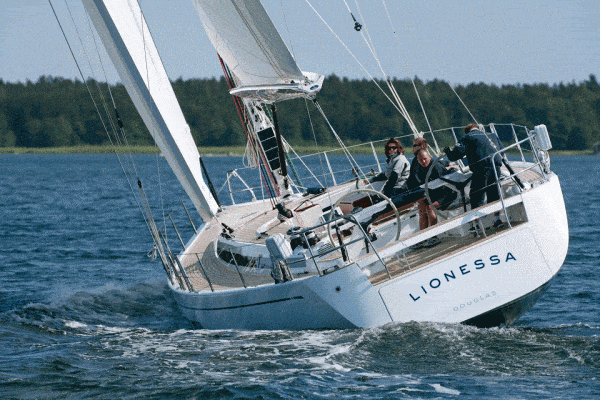
Later in the afternoon, as we headed up the bay under gennaker and diminishing wind, we slowed to 5 to 6 knots. Throughout the sea trial, Lionessa steered accurately, showing a moderate amount of drag from the autopilot. She’d have a fingertip helm with the pilot disconnected. She tacked quickly and positively, accelerating briskly when I steered out of the tack at the right time. Sight lines over the low-profile trunk cabin were excellent, whether I steered from the high side or low side.
I was reluctant to leave the boat, because this sea trial, like nearly every other, didn’t last long enough for me to become well acquainted with the vessel. I suspect, though, that this Swan and I would enjoy one another’s company for quite a long time.
View a complete photo gallery here.
LOA: 66’0″
LWL: 56’3″
BEAM: 17’8″
DRAFT: 10’6″
DISPL.: 66,000 lb.
SAIL AREA: 2,336 sq. ft.
SAIL AREA/DISPL. RATIO: 22.89
DISPL./LWL RATIO: 167.78
FUEL: 211 gal.
WATER: 264 gal.
ENGINE: 1 x 160 hp Steyr MO166K28 6-cylinder diesel
PRICE: $4,530,000 (approx.)
Nautor’s Swan USA East, 401-846-1090; www.usaeast.nautorswan .com; USA West, 510-236-6633; www.usawest.nautorswan.com




